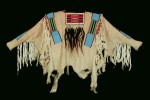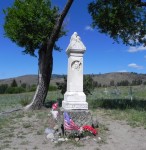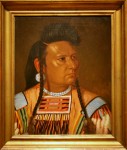 Today in depressing auction news, a beaded, quilled hide shirt with white weasel fur fringe and human hair decoration worn by Nez Perce leader Chief Joseph sold at the Coeur d’Alene Art Auction in Reno, Nevada on July 21st for $877,500 to yet another anonymous private collector. This particular garment is of major historical significance. Chief Joseph was wearing it in the first photograph ever taken of him and in a painting by Cyrenius Hall that is now in the Smithsonian’s National Portrait Gallery. The Hall portrait was also used in 1968 to make a postage stamp dedicated to the great chief.
Today in depressing auction news, a beaded, quilled hide shirt with white weasel fur fringe and human hair decoration worn by Nez Perce leader Chief Joseph sold at the Coeur d’Alene Art Auction in Reno, Nevada on July 21st for $877,500 to yet another anonymous private collector. This particular garment is of major historical significance. Chief Joseph was wearing it in the first photograph ever taken of him and in a painting by Cyrenius Hall that is now in the Smithsonian’s National Portrait Gallery. The Hall portrait was also used in 1968 to make a postage stamp dedicated to the great chief.
 The shirt was dispersed with the rest of his belongings at a potlatch — a ceremonial gift-giving feast in which goods both material and spiritual are redistributed and/or traded — hosted by Chief Joseph’s widow the summer after his death in September of 1904. He had been buried immediately after his death, but in June of 1905, a white marble monument was erected to his memory in the historic Nez Perce cemetery in Nespelem, Washington. He was reburied under the new monument with great ceremony on June 20, 1905.
The shirt was dispersed with the rest of his belongings at a potlatch — a ceremonial gift-giving feast in which goods both material and spiritual are redistributed and/or traded — hosted by Chief Joseph’s widow the summer after his death in September of 1904. He had been buried immediately after his death, but in June of 1905, a white marble monument was erected to his memory in the historic Nez Perce cemetery in Nespelem, Washington. He was reburied under the new monument with great ceremony on June 20, 1905.
An article in the Seattle Post-Intelligencer newspaper of June 25, 1905 describes the event:
The Chief Joseph potlatch took place Friday. It was one of the greatest affairs of the kind we have any record of. The huge council lodge was filled. At the head of the lodge were gathered heaps of the worldly possessions of the late Chief Joseph. … After dinner speeches were made, the crowning of which was made by Chief Yellow Bull. The speech was made on horseback while the old chief rode slowly three times around the outside of the big council lodge. He rode Chief Joseph’s faithful old horse and besides that dignity he wore all of Chief Joseph’s war clothes, including the famous eagle feather war bonnet. His speech related almost wholly to the greatness of the man whose clothes he was wearing. …
The great war bonnets and war clothing went to the three nephews. A dozen watches were among the gifts, three fine guns and an endless array of blankets. One of the three buffalo robes was given to Three Knives, or Professor Meany.
So presumably this shirt passed into the hands of one of Chief Joseph’s nephews in 1905, but there is no record of it after that for another 90 years. Its prominent presence in national iconography notwithstanding, the shirt disappeared into the market and was purchased by a collector at an Indian relic show some time in the 1990s. Neither the seller nor buyer had any idea of who had worn this shirt and when. It was sold purely as an exquisite Native American craft in excellent condition. That collector then sold it to another collector who researched the piece thoroughly and was able to identify it as the shirt worn by Chief Joseph in the 1877 picture and the 1878 oil painting. Experts confirmed that it could not have been a later forgery based on the images. The crafts and materials simply cannot be duplicated.
 Pictorial evidence is the best evidence there is for the provenance of an object like this. Another war shirt attributed to Chief Joseph sold at Sotheby’s this May for $482,500 because even though there was an impressive paper trail and oral history linking the shirt step by step to Chief Joseph’s cousin Peo-Peo-Tholekt who is said to have received it at the 1905 potlatch, there is no direct evidence that it was ever worn by the chief. One picture is worth a thousand words and $400,000, I suppose.
Pictorial evidence is the best evidence there is for the provenance of an object like this. Another war shirt attributed to Chief Joseph sold at Sotheby’s this May for $482,500 because even though there was an impressive paper trail and oral history linking the shirt step by step to Chief Joseph’s cousin Peo-Peo-Tholekt who is said to have received it at the 1905 potlatch, there is no direct evidence that it was ever worn by the chief. One picture is worth a thousand words and $400,000, I suppose.
The picture in question marks an incredibly sad period in Chief Joseph’s life and in the miserably awful history of the United States’ dealings with the Native Americans.
In 1855, Joseph’s father known as Chief Joseph the Elder and a council of other Nez Perce chiefs signed a treaty with the US establishing a 7.7 million acre reservation covering traditional tribal lands in Idaho, Washington, and Oregon. Among them was the Wallowa Valley, the ancestral land of Joseph’s tribe. In 1863, under pressure from settlers and gold rushers, some of the Nez Perce tribes signed a new treaty establishing a 780,000 acre reservation which did not include the Wallowa Valley. Joseph the Elder refused to sign, as did other chiefs, this creating a rift between the “treaty” and “non-treaty” Nez Perce peoples.
On his deathbed in 1871, Chief Joseph the Elder told his son “This country holds your father’s body. Never sell the bones of your father and your mother.” Chief Joseph promised. He never fought the white settlers or the US government with weapons and bloodshed, but he struggled at council after council to ensure his people remained in the Wallowa Valley. Treaties were made that were of course broken whenever the US felt like it. Finally in 1877, Army General Oliver Howard gave Chief Joseph an ultimatum: move out of the valley to the Idaho reservation or we’ll consider it an act of war.
 Then began a massive flight. The Nez Perce, pursued by the US Army, first fled east hoping the Crow nation would allow them to settle on their lands. The Crow did not, so Chief Joseph’s people moved north hoping to cross the border into Canada. They almost made it. Just 40 miles from the border near Snake Creek in the Bear Paw Mountains of Montana Territory, Chief Joseph and the US Army fought a five day battle. Freezing, starving, his warrior ranks decimated, Chief Joseph surrendered to General Howard. Chief Joseph’s speech, ostensibly recorded as is but very possibly embellished by Lieutenant Charles Erskine Scott Wood, has gone down in history:
Then began a massive flight. The Nez Perce, pursued by the US Army, first fled east hoping the Crow nation would allow them to settle on their lands. The Crow did not, so Chief Joseph’s people moved north hoping to cross the border into Canada. They almost made it. Just 40 miles from the border near Snake Creek in the Bear Paw Mountains of Montana Territory, Chief Joseph and the US Army fought a five day battle. Freezing, starving, his warrior ranks decimated, Chief Joseph surrendered to General Howard. Chief Joseph’s speech, ostensibly recorded as is but very possibly embellished by Lieutenant Charles Erskine Scott Wood, has gone down in history:
Tell General Howard I know his heart. What he told me before, I have it in my heart. I am tired of fighting. Our chiefs are killed; Looking Glass is dead, Too-hul-hul-sote is dead. The old men are all dead. It is the young men who say yes or no. He who led on the young men is dead. It is cold, and we have no blankets; the little children are freezing to death. My people, some of them, have run away to the hills, and have no blankets, no food. No one knows where they are—perhaps freezing to death. I want to have time to look for my children, and see how many of them I can find. Maybe I shall find them among the dead. Hear me, my chiefs! I am tired; my heart is sick and sad. From where the sun now stands, I will fight no more forever.
The 600 or so surviving Nez Perce were forced to march 400 miles to Fort Keogh, Montana Territory, where they arrived on October 13th, 1877. It was there that post photographer John F. Fouch took the first picture of Chief Joseph ever taken. He was wearing the war shirt as he sat for the picture. From the auction website:
Joseph is seated in the photo and his hands appear frostbitten. Yet, his hair is pushed up in a proud warrior pompadour and he is dressed resplendent in his shirt. Examination of details in the photo leaves no question that the shirt in the Fouch photo is one and the same as the shirt here under discussion. Note and compare the varying lengths of quill wrappings on the hair locks under the neck flap, the short fringe cuts at the end of the sleeves, and the alignment of bead decoration on the neck flap, shoulder and sleeve strips. (Color values of the orthochromatic film used in the 1870’s do not always appear as they do in the later panchromatic film.) Several of the red wool wrapped ermine skin fringes have been secured with pericardium and match up from photo to shirt, especially on Joseph’s left shoulder.
After their stay in Fort Keogh, General William Tecumseh Sherman sent Joseph and 400 of his people to the prisoner of war camp in Fort Leavenworth, Kansas. At Leavenworth, painter Cyrenius Hall made his portrait of Chief Joseph, again wearing the shirt.
 The Nez Perce were kept prisoner at Fort Leavenworth for eight months, then moved to Indian Territory in what is today Oklahoma. They lived there (in a manner of speaking; many died there) for seven years. During this time, Chief Joseph tirelessly fought for them to be allowed to return to their ancestral lands, personally pleading their case before presidents, politicians, intellectuals and in the press.
The Nez Perce were kept prisoner at Fort Leavenworth for eight months, then moved to Indian Territory in what is today Oklahoma. They lived there (in a manner of speaking; many died there) for seven years. During this time, Chief Joseph tirelessly fought for them to be allowed to return to their ancestral lands, personally pleading their case before presidents, politicians, intellectuals and in the press.  Read his riveting account of the history of his people and the patronizing, stupid introduction to it in “An Indian’s Views of Indian Affairs” from the North American Review of April 1879. It’s enough to make you pop a blood vessel, I swear.
Read his riveting account of the history of his people and the patronizing, stupid introduction to it in “An Indian’s Views of Indian Affairs” from the North American Review of April 1879. It’s enough to make you pop a blood vessel, I swear.
In 1885 Chief Joseph’s Nez Perce tribe was allowed to go back to the Pacific Northwest, but not to the Wallowa Valley. Even once settled in Washington’s Colville Reservation, until the end of his days in 1904 Joseph never stopped advocating for his people to be treated with reason and respect, and for their right to return to their ancestral homelands.